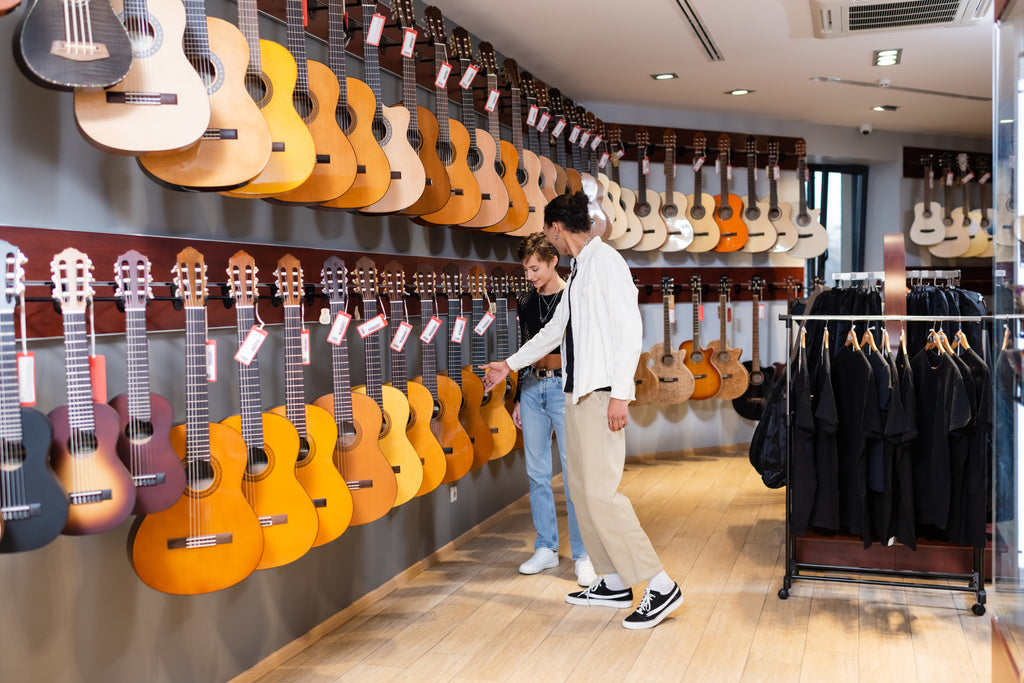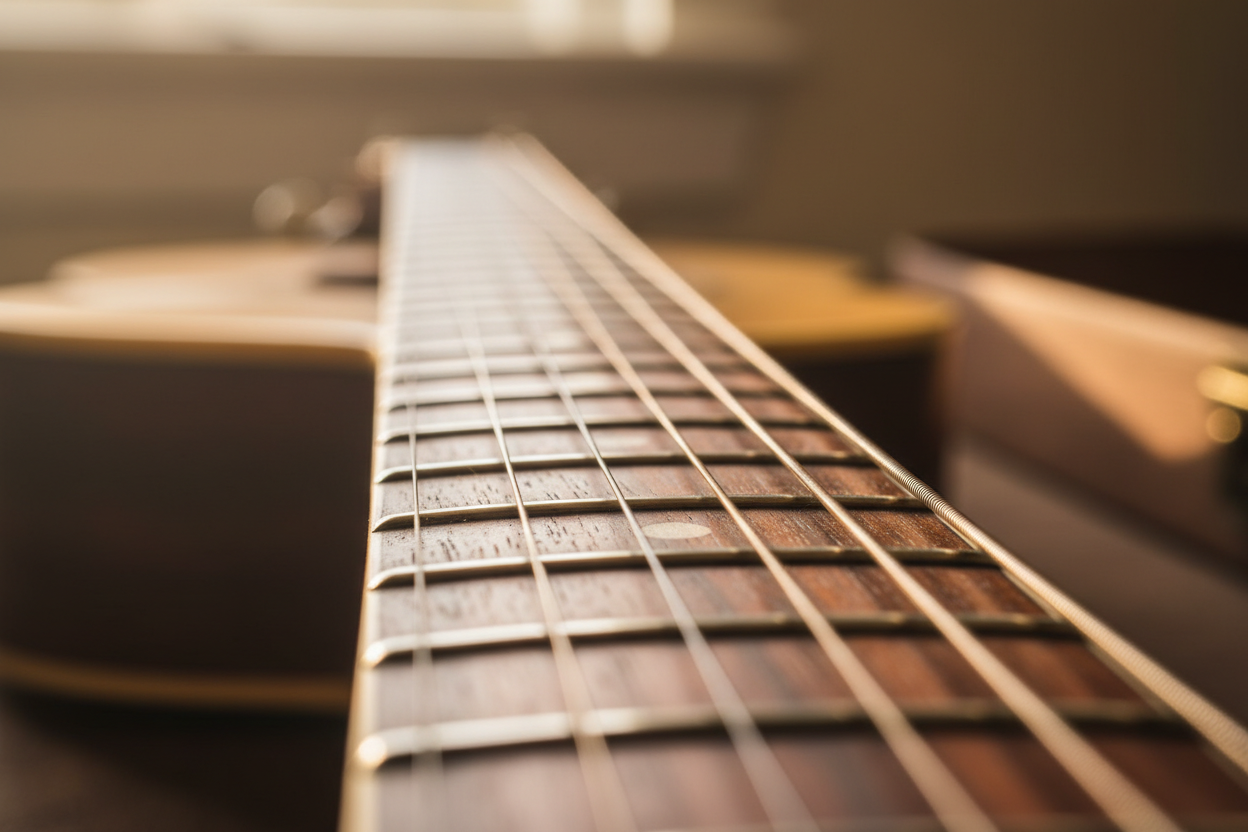Wooden parts of a guitar are commonly called “tonewoods” because they greatly affect its overall sound. When strings are plucked, they produce different frequencies, which bounce off the walls of tonewoods before producing the final result.
However, there’s far more to tonewoods than that. Each type of wood possesses unique characteristics while the quality of the wood and the refining process also contribute to the sound-shaping process.
This article was created to help guitarists understand the depth of impact tonewoods have on acoustic guitars, which can be of invaluable help when it comes to choosing the right acoustic guitar and harnessing its tonewoods to the fullest.
Tonewood Quality
The unique characteristics and physical attributes of different types of tonewood dictate whether they’ll “contain” the sonic frequencies or amplify them. Moreover, we differentiate between “warm” and “bright” sounding tonewoods, or in other words, wood that typically produces overemphasized low or high frequencies.
Generally speaking, harder tonewoods are typically bright while softer tonewoods are usually warm. If properly preserved and refined by skilled artisans, older tonewoods are preferred over freshly cut ones since most types of wood gain additional properties as they age.
Wood grain is still a very important factor that determines how tonewoods affect the guitar’s parts and the overall sound, even though many companies have access to technologies allowing them to choose and assemble the best wood parts without leaving trace marks. The next section is meant to help you understand how tonewood quality is gauged before being processed.
Stiffness
Stiffness determines the flexibility of the wood. Whenever strings are plucked, the vibrations apply pressure to the wood.
Stiff tonewoods remain unphased, sacrificing resonance for the sake of a more consistent tone. Flexible tonewoods, on the other hand, allow frequencies to roam more freely and essentially “activate” the entire body, resulting in more present undertones and better expression.
Age
As wood ages, it dries up and becomes gradually lighter. Moisture does more than add weight to the guitar’s tonewood - it also “soaks up” a portion of the frequencies, leading to a less defined tone.
That’s why vintage guitars are typically more expensive than instruments made from fresh wood. Old wood greatly amplifies the guitar’s sonic resonance, allowing the vibrating frequencies to fully blossom.
Grain
The lines of fiber stretched across a cut piece of wood are commonly referred to as “grain”. Guitars uncoated with paint often feature clearly visible patterns that can tell you which parts of the wood were used to create its body, top, and sides.
More importantly, grain lines tell us how our guitars will age. Wood tends to be more flexible across the grain and stiffer along its path. However, it also contracts and expands faster and to higher magnitudes across grain patterns.
Common Guitar Tonewood Types
Each type of acoustic guitar tonewood has a different set of characteristics unique to it. In the following sections, we’ll list some of the most popular tonewood types and their primary attributes.
Basswood
Balanced, moderately soft, and typically with tight grain patterns, basswood is commonly used in affordable acoustic guitars. It has a somewhat warm tone, but it doesn’t resonate lows as well as mahogany or rosewood.
Mahogany
A dominantly warm-sounding wood, mahogany is easily the most popular acoustic guitar tonewood. It’s sturdier than most contemporary alternatives and offers exceptional resonance. When properly refined and aged, it could compete with high-end tonewoods like ebony.
Ash
Not as popular as mahogany, rosewood, or basswood, Ash is still a decent choice for luthiers looking for a cheaper alternative to bright-sounding maple. Its main attribute is superb sustain, which is something most easily accessible tonewoods lack.
Maple
Maple is among the brightest-sounding tonewoods that acoustic guitar makers prefer due to its great durability and characteristic tone. It tends to be slightly heavier than most tonewoods, and its unique grain patterns often yield varied results.
Myrtlewood

Often compared to Maple even though its position on the sonic spectrum is far more balanced, Myrtlewood is a gorgeous type of tonewood with subtle but powerful characteristics.
Similar to Maple wood, Myrlewood reinforces the tone derived from other tonewoods rather than coloring it with its own mark. It will also enrich your guitar’s sustain and guitars featuring it are typically durable enough to last decades if properly maintained.
Breedlove is among the most popular guitar-making companies that specialize in Myrtlewood acoustic instruments. If you’re looking for premium high-end acoustic guitars made of Myrtlewood, we recommend checking out Breedlove’s Oregon series.
Rosewood
Widely praised for its exquisite aesthetic elements, Rosewood is a warm-sounding tonewood with good volume. High-end luthiers with access to the acclaimed Brazilian rosewood charge their acoustic guitars dearly, but they are some of the best in the current market.
Ebony
One of the most expensive tonewoods out there, Ebony rivals the bright tones of maple wood while surpassing it in terms of flexibility, porousness, and sturdiness. It’s very difficult to work with, and most luthiers refine and assemble guitars with ebony by hand.
Spruce
Spruce is one of the most popular tonewoods for acoustic guitar tops for a good reason. With exceptional projection and resonance paired with characteristically loud volume, spruce can make even steel-strung logs sound great. Often compared to mahogany even though it’s a bright-sounding tonewood, Spruce is very easy to work with and readily available, meaning that you won’t have to look long and hard to find an acoustic guitar with a top made of this wood.
Cedar
Another tonewood that is primarily used in manufacturing guitar tops, Cedar is a decently balanced type of wood that synergizes with tonewoods on the back and sides, augmenting their innate capabilities with better responsiveness. Slightly darker compared to Spruce but brighter than Rosewood and Mahogany, Cedar will enrich your guitar’s sound with abundant undertones and reverb.
Guitar-Making Techniques that Change Tonewood Properties
To fully utilize the desired effects and diminish the negative ones, acoustic guitar makers know how to manipulate guitar tonewoods by designing different kinds of bracing, soundholes of different sizes, and such. The quality of the tonewood itself is equally important as the type of wood that is used in the manufacturing process.
Finally, the tonewood refining process and the techniques used therein also play significant roles in determining the impact any tonewood has on the acoustic guitar’s overall sound. Let’s explore these parameters in more detail.
Solid Acoustic Guitars vs Laminate Guitars
Before any guitar is made, companies and luthiers have to decide its construction type. This decision is usually based on the availability of chosen tonewoods, how easy the wood is to work with, the project’s budget, the ideal customer/player, and finally, the guitar’s price.
Solid wood guitars are expensive and difficult to make, but they sound the best, and professionals wouldn’t even consider any alternatives because of this. In short, if a piece of tonewood is refined and then used in its entirety, it’s considered a “solid wood”. If it’s cut into smaller pieces (that are much easier to work with) and then layered into the guitar’s body, top, or sides, then we’re talking about a “laminating” technique.
Solid wood guitars are louder, have a more characteristic tone, and generally sustain it much better. The acoustics simply work better with solid tonewoods because there are no micro-sized holes where the sound can escape.
Laminate wood guitars aren’t bad per se. For instance, beginners probably wouldn’t be able to tell the difference between an entry-level solid and an entry-level laminate guitar. But they are far inferior to solid wood guitars in terms of tone, resonance, presence, and projection. You’ll rarely find a laminate guitar made of exotic tonewoods like Ebony - laminate Basswood guitars are far more common.
The last “type” of guitar construction combines solid and laminate parts. For instance, a guitar may have a solid top while its back and sides are laminated.
Bracing and Internal Architecture
Acoustic guitars typically feature a variety of “struts”, which are wooden pieces meant to enhance several aspects of the tonewoods. Depending on how and where these struts are placed, the guitar may feature improved flexibility, volume, sustain, or soundhole responsiveness.
These braces are placed in different positions and angles across the guitar’s back and top. For instance, standard walnut tonewoods aren’t overly loud, but when cantilevered bracing (such as Taylor’s patented C-Class bracing) is deployed, their volume increases significantly.
Soundhole Design
Unlike electric guitars that heavily rely on electric pickups to produce a sound, acoustic guitars rely on pure acoustic sound transmissions to create a tone. Certain tonewoods allow frequencies to ricochet well against the walls while certain types (such as maple) lead to rapid note decay.
Dense tonewoods, such as plain hardwood or laminate, usually struggle with this issue, which can be a problem for gigging musicians who need guitars with plenty of sustain. To counter this problem, luthiers must design an appropriate soundhole.
In essence, soundholes are like air pumps on acoustic guitars, propelling the sound throughout the guitar’s body when the strings are plucked, and ultimately forcing it outward. The design of the soundhole affects the vibrations and is usually meant to synergize with the physical elements of the tonewoods.
It’s a common practice to build larger soundholes on guitars built from warm tonewoods (and vice versa) to put a stronger emphasis on the frequencies that the wood struggles to project.
Conclusion
The type of wood that is used in the guitar-making process practically defines its tone. However, the combination of tonewoods is arguably just as important. Some wood types sit in perfect harmony, like Ebony and Maple, or Rosewood and Mahogany, but combining tonewoods with opposing elements often defeats the purpose.
The process of refining tonewoods also plays a key role in determining the acoustic guitar’s tone. Machine-assembled guitars typically offer very low resonance, which is why so many of them sound almost exactly the same.
The rest is up to the player. As numerous iconic players often say, the tone is ultimately in the guitarist’s fingers. More specifically, it’s up to the player to choose a guitar with the characteristics that fit their playing style and genre and learn how to fully utilize the benefits its tonewoods have to offer.





